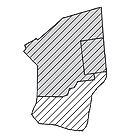|
|
Early Islamic Period, 638-1099 CE
|

|
"Jerusalem is smaller than Mecca and larger than Medina. Above the city there is a fortress one side of which faces a hill in the city and the other side is protected by a moat. Jerusalem has eight iron gates: (1) Bab Sihyun (Gate of Zion) (2) Bab at Tih (Gate of the desert of the wanderings) (3) Bab al Balat (Gate of the Palace or Court) (4) Bab Jubb Armiya (Gate of Jeremiah's Pit) (5) Bab Silwan (Gate of Siloam) (6) Bab Ariha (Gate of Jericho) (7) Bab al `Amud (Gate of the Columns) (8) Bab Mihrab Daud (Gate of David's Oratory)".
(Al-Muqaddasi, 980 CE)
Jerusalem capitulated to the Arab conquerors in 638 CE, after a two year siege. The beginning of the period was characterized by extensive construction projects in Jerusalem initiated by the Umayyad caliph, Abd al-Malik and his successors (end of the seventh century and beginning of the eighth century CE). Noteworthy among the projects are the rehabilitation of the Temple Mount walls, parts of the Western Wall, Wilson's Arch, the construction of a network of streets around the Temple Mount and a bridge from the magnificent palace to the Al-Aqsa Mosque and repairs to the roads that led to the city. The Byzantine city walls continued to be used after they underwent fundamental repairs, for example, the Byzantine wall was left intact in the southeastern corner of the Temple Mount while a new wall was constructed where other sections of it were ruinous. They began fortifying the inside of the citadel by constructing a kind of inner stronghold and a round tower.
In 1033 CE an earthquake struck Jerusalem and destroyed its fortifications. Until that year the southern walls enclosed Mount Zion and the hill of the City of David along the same route that the walls of the fifth century followed (Eudocia's wall). After the earthquake the shortened route of the southern wall was built, which exists to this day. Mount Zion and its churches remained outside the city limits as did the Jewish neighborhoods located south of the Temple Mount.
The Christians set about building the wall in the northwestern corner and it was completed in 1063. At the end of the period the Seljuk government was replaced by Fatimid rule, which was accompanied by much destruction.
Finds:
Many Umayyad remains were discovered in excavations that were conducted south and west of the Temple Mount, as well as on Mount Zion and in the City of David.
Historical Sources:
One of the most important written sources available to us is that of the Arab geographer Al-Muqaddasi who was a resident of Jerusalem. Another source is the descriptions of the Crusaders who besieged the city before it was conquered in which they describe the city walls, their strength and their towers.
|
|

|
| The city walls in the Early Islamic period |
|
 |
 |
|
|
| Websites, text and photos © Israel Antiquities Authority |
Powered by teti-tu |
|
|















